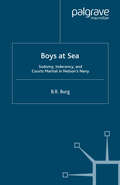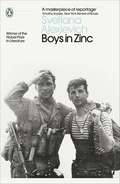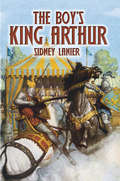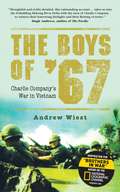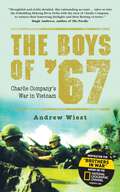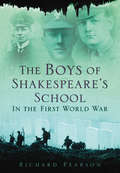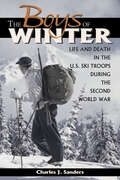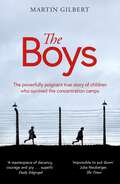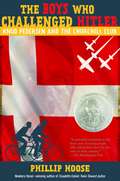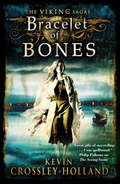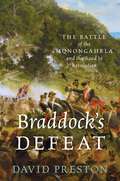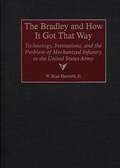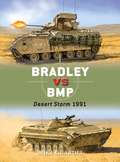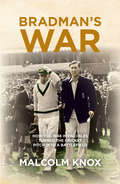- Table View
- List View
Boys at Sea: Sodomy, Indecency, and Courts Martial in Nelson's Navy
by B. BurgBoys at Sea is a study of homoerotic life in the Royal Navy during the age of sail. The book traces every feature of sexual life at sea, including seduction, rape, prostitution, courts martial, and the punishments meted out to those convicted of violating the stern moral code set down in the Articles of War .
The Boys In The Boat: An Epic Journey to the Heart of Hitler's Berlin
by Daniel James BrownThe inspiration for the major film of the same name directed by George Clooney, this is the bestselling story about a rowing team's quest for Olympic gold in Nazi Germany. 'A moving, enlightening and gripping tale' - Financial TimesCast aside by his family at an early age, abandoned and left to fend for himself in the woods of Washington State, young Joe Rantz turns to rowing as a way of escaping his past.What follows is an extraordinary journey, as Joe and eight other working-class boys exchange the sweat and dust of life in 1930s America for the promise of glory at the heart of Hitler’s Berlin. Stroke by stroke, a remarkable young man strives to regain his shattered self-regard, to dare again to trust in others – and to find his way back home.Told against the backdrop of the Great Depression, Daniel James Brown's The Boys in the Boat is narrative non-fiction of the first order; a personal story full of lyricism and unexpected beauty that rises above the grand sweep of history, and captures instead the purest essence of what it means to be alive.‘I really can't rave enough about this book . . . I read the last fifty pages with white knuckles, and the last twenty-five with tears in my eyes’ – David Laskin, author of The Children's Blizzard and The Long Way Home.
Boys in Zinc (Penguin Modern Classics)
by Andrew Bromfield Svetlana AlexievichThe haunting history of the Soviet-Afghan War from the winner of the Nobel Prize in Literature 2015- A new translation based on the updated text - From 1979 to 1989 Soviet troops engaged in a devastating war in Afghanistan that claimed thousands of casualties on both sides. While the Soviet Union talked about a 'peace-keeping' mission, the dead were shipped back in sealed zinc coffins. Boys in Zinc presents the honest testimonies of soldiers, doctors and nurses, mothers, wives and siblings who describe the lasting effects of war. Weaving together their stories, Svetlana Alexievich shows us the truth of the Soviet-Afghan conflict: the killing and the beauty of small everyday moments, the shame of returned veterans, the worries of all those left behind. When it was first published in the USSR in 1991, Boys in Zinc sparked huge controversy for its unflinching, harrowing insight into the realities of war.
The Boy's King Arthur: Being Sir Thomas Malory's History Of King Arthur And His Knights Of The Round Table - Primary Source Edition (Dover Children's Classics)
by Sidney LanierThis rousing collection of tales offers readers an adventure-packed introduction to the legendary King Arthur and his Knights of the Round Table. Retold by the famous American poet and writer Sidney Lanier, the stories are adapted from Sir Thomas Malory's Le Morte d'Arthur, written in the15th century. The tales are told in the style and language of the original. Readers will thrill to the glorious adventures of Arthur and his knights: the mysterious birth of Arthur, how Arthur pulled the sword from the stone to become King of England, Sir Percival's search for the Holy Grail, the tragic romance of Tristram and Isolde, Launcelot's gallant battle to save Queen Guenevere from a death sentence, and Arthur's final struggle with the evil Sir Mordred. These stories capture the age-old drama and romance surrounding the fabled king and his followers, all sworn to uphold lofty ideals of courage, honesty, loyalty, and devotion. This inexpensive volume invites a new generation of readers to enjoy these time-honored tales of gallant knights and fair ladies. These stories have inspired numerous film adaptations, including the 2017 release King Arthur: Legend of the Sword, directed by Guy Ritchie and starring Charlie Hunnam, Jude Law, Eric Bana, Djimon Hounsou, and Annabelle Wallis.
The Boys of ’67: Charlie Company’s War in Vietnam
by Andrew WiestIn the spring of 1966, while the war in Vietnam was still popular, the US military decided to reactivate the 9th Infantry Division as part of the military build-up. Across the nation, farm boys from the Midwest, surfers from California and city-slickers from Cleveland opened their mail to find greetings from Uncle Sam. Most American soldiers of the Vietnam era trickled into the war zone as individual replacements for men who had become casualties or had rotated home. Charlie Company was different as part of the only division raised, drafted and trained for service. From draft to the battlefields of South Vietnam, this is the unvarnished truth from the fear of death to the chaos of battle, told almost entirely through the recollections of the men themselves. This is their story, the story of young draftees who had done everything that their nation had asked of them and had received so little in return – lost faces of a distant war.
The Boys of ’67: Charlie Company’s War in Vietnam (General Military Ser.)
by Andrew WiestIn the spring of 1966, while the war in Vietnam was still popular, the US military decided to reactivate the 9th Infantry Division as part of the military build-up. Across the nation, farm boys from the Midwest, surfers from California and city-slickers from Cleveland opened their mail to find greetings from Uncle Sam. Most American soldiers of the Vietnam era trickled into the war zone as individual replacements for men who had become casualties or had rotated home. Charlie Company was different as part of the only division raised, drafted and trained for service. From draft to the battlefields of South Vietnam, this is the unvarnished truth from the fear of death to the chaos of battle, told almost entirely through the recollections of the men themselves. This is their story, the story of young draftees who had done everything that their nation had asked of them and had received so little in return – lost faces of a distant war.
The Boys of Shakespeare's School in the First World War: In The First World War
by Richard PearsonLike many young men of the time, the boys of King Edward VI School saw the outbreak of the First World War as an opportunity for bravery and excitement. By the time the Armistice was signed in late 1918, thirty-one old boys and one Master had been killed. For such a small grammar school the cost was significant, as too were the number of awards for gallantry, including a Victoria Cross. Set against Stratford-upon-Avon and the boys’ schooldays, this intriguing book details the boys’ war and their involvement in the major battles on the Western Front, in Italy, Salonika, Macedonia, Gallipoli, Bulgaria and Russia. Ultimately a tragic and moving account, it captures the heart of a small community and represents the sense of adventure with which young men went to war.
The Boys of Winter: Life and Death in the U.S. Ski Troops During the Second World War
by Charles J. Sanders"An immensely valuable and substantial addition to 10th Mountain literature and to the history of skiing in the United States." - International Ski History Association The Boys of Winter tells the true story of three young American ski champions and their brutal, heroic, and fateful transformation from athletes to infantrymen with the 10th Mountain Division. Charles J. Sanders's fast-paced narrative draws on dozens of interviews and extensive research to trace these boys' lives from childhood to championships and from training at Mount Rainier and in the Colorado Rockies to battles against the Nazis.
The Boys: Triumph Over Adversity
by Sir Martin GilbertIn August 1945, the first of 732 child survivors of the Holocaust reached Britain. First settled in the Lake District, they formed a tightly knit group of friends whose terrible shared experience is almost beyond imagining. This is their story, which begins in the lost communities of pre-World War II central Europe, moves through ghetto, concentration camp and death march, to liberation, survival, and finally, fifty years later, a deeply moving reunion. Martin Gilbert has brought together the recollections of this remarkable group of survivors. With magisterial narration, he tells their astonishing stories. The Boys bears witness to the human spirit, enduring the depths, and bearing hopefully the burden and challenge of survival.'Martin Gilbert is to be congratulated on producing a masterly and deeply moving tribute to those who had the courage and luck to survive' Literary Review
The Boys Who Challenged Hitler: Knud Pedersen And The Churchill Club
by Phillip HooseAt the outset of World War II, Denmark did not resist German occupation. Deeply ashamed of his nation's leaders, fifteen-year-old Knud Pedersen resolved with his brother and a handful of schoolmates to take action against the Nazis if the adults would not. Naming their secret club after the fiery British leader, the young patriots in the Churchill Club committed countless acts of sabotage, infuriating the Germans, who eventually had the boys tracked down and arrested. But their efforts were not in vain: the boys' exploits and eventual imprisonment helped spark a full-blown Danish resistance. Interweaving his own narrative with the recollections of Knud himself, The Boys Who Challenged Hitler is National Book Award winner Phillip Hoose's inspiring story of these young war heroes. This thoroughly-researched and documented book can be worked into multiple aspects of the common core curriculum.
Boys Will Be Boys: The Story of Sweeney Todd, Deadwood Dick, Sexton Blake, Billy Bunter, Dick Barton et al.
by E. S. TurnerE.S. Turner's first book, published in 1948, is a wholly original, richly researched and uncommonly insightful study of a somewhat disreputable genre: the 'Boys' Weekly' papers commonly known as 'penny dreadfuls.''A classic of its kind... [Turner] ploughed through back numbers of the old blood-and-thunder adventure magazines specialising in cliffhanger serials; the young hero would be left hanging over a cliff in a totally impossible situation, which would be easily resolved in the next issue: 'With one bound Jack was free.' Social history had never been as much fun or, with three extra printings in its first week - such was the demand - as profitable.' Jonathan Sale, Guardian 'Some people felt that E.S. Turner may have invented a new kind of book - the popular social history, very British, very funny, but written with a glistening elegance.'Andrew O'Hagan, London Review of Books
Boyz 'n' the Hood: 'A' Level Media Studies Information Packs (BFI Film Classics)
by Tess Forbes Andrew OrmsbyThis information pack is produced for the Cambridge Media Studies A Level (Syllabus A, Paper 3). It contains an annotated bibliography, a list of annotated journal references, newspaper articles and reviews.
Boyz 'n' the Hood: 'A' Level Media Studies Information Packs (BFI Film Classics)
by Tess Forbes Andrew OrmsbyThis information pack is produced for the Cambridge Media Studies A Level (Syllabus A, Paper 3). It contains an annotated bibliography, a list of annotated journal references, newspaper articles and reviews.
Brabbling Women: Disorderly Speech and the Law in Early Virginia
by Terri L. SnyderBrabbling Women takes its title from a 1662 law enacted by Virginia's burgesses, which was intended to offer relief to the "poore husbands" forced into defamation suits because their "brabling" wives had slandered or scandalized their neighbors. To quell such episodes of female misrule, lawmakers decreed that husbands could choose either to pay damages or to have their wives publicly ducked.But there was more at stake here. By examining women's use of language, Terri L. Snyder demonstrates how women resisted and challenged oppressive political, legal, and cultural practices in colonial Virginia. Contending that women's voices are heard most clearly during episodes of crisis, Snyder focuses on disorderly speech to illustrate women's complex relationships to law and authority in the seventeenth century.Ordinary women, Snyder finds, employed a variety of strategies to prevail in domestic crises over sexual coercion and adultery, conflicts over women's status as servants or slaves, and threats to women's authority as independent household governors. Some women entered the political forum, openly participating as rebels or loyalists; others sought legal redress for their complaints. Wives protested the confines of marriage; unfree women spoke against masters and servitude. By the force of their words, all strove to thwart political leaders and local officials, as well as the power of husbands, masters, and neighbors. The tactics colonial women used, and the successes they met, reflect the struggles for empowerment taking place in defiance of the inequalities of the colonial period.
Bracelet of Bones: Book 1 (The Viking Sagas)
by Kevin Crossley-HollandThe breathtaking new adventure from the bestselling and multi-award-winning Kevin Crossley-Holland. One morning Solveig wakes to find her father has broken his promise. Halfdan, a Viking mercenary, has followed the young warrior Harald Hardrada to Miklagard (Constantinople), where he is leader of the Empress's guard.Solveig sets off in a tiny boat to find him. So begins a fierce journey of discovery and survival, where the young Viking girl will meet a ghost ship and befriend an English slave, shoot rapids, survive an arrow storm, and witness a living sacrifice. Will Solveig reach Miklagard? And will her father be there?Bracelet of Bones is a glittering novel about fathers and daughters, the clash of religions, courage and self-reliance and a perilous journey to young womanhood.
Bracing for Armageddon: Why Civil Defense Never Worked
by Dee GarrisonIn Bracing for Armageddon, Dee Garrison pulls back the curtain on the U.S. government's civil defense plans from World War II through the end of the Cold War. Based on government documents, peace organizations, personal papers, scientific reports, oral histories, newspapers, and popular media, her book chronicles the operations of the various federal and state civil defense programs from 1945 to contemporary issues of homeland security, as well as the origins and development of the massive public protest against civil defense from 1955 through the 1980s. At a time of increasing preoccupation over national security issues, Bracing for Armageddon sheds light on the growing distrust between the U.S. government and its subjects in postwar America.
Bracing for Armageddon: Why Civil Defense Never Worked
by Dee GarrisonIn Bracing for Armageddon, Dee Garrison pulls back the curtain on the U.S. government's civil defense plans from World War II through the end of the Cold War. Based on government documents, peace organizations, personal papers, scientific reports, oral histories, newspapers, and popular media, her book chronicles the operations of the various federal and state civil defense programs from 1945 to contemporary issues of homeland security, as well as the origins and development of the massive public protest against civil defense from 1955 through the 1980s. At a time of increasing preoccupation over national security issues, Bracing for Armageddon sheds light on the growing distrust between the U.S. government and its subjects in postwar America.
Brackenbeck
by Margaret DickinsonAt the beginning of the twentieth century a female doctor was often treated with mistrust. In Margaret Dickinson's Brackenbeck, Doctor Katharine Harvey goes to the village of Brackenbeck to take over Doctor Anthony Stafford's practice, only to find the villagers resent her presence and will not acknowledge her as a fully qualified doctor. Katharine soon learns that the villagers follow the lead of Jim Kendrick, owner of Brackenbeck quarry, and Jim doesn't like women doctors. Katherine's destiny lies in his hands. When tragedy strikes the village, Jim and the people of Brackenbeck need her help - but will they change their minds?
Braddock's Defeat: The Battle of the Monongahela and the Road to Revolution (Pivotal Moments in American History)
by David L. PrestonOn July 9, 1755, British regulars and American colonial troops under the command of General Edward Braddock, commander in chief of the British Army in North America, were attacked by French and Native American forces shortly after crossing the Monongahela River and while making their way to besiege Fort Duquesne in the Ohio Valley, a few miles from what is now Pittsburgh. The long line of red-coated troops struggled to maintain cohesion and discipline as Indian warriors quickly outflanked them and used the dense cover of the woods to masterful and lethal effect. Within hours, a powerful British army was routed, its commander mortally wounded, and two-thirds of its forces casualties in one the worst disasters in military history. David Preston's gripping and immersive account of Braddock's Defeat, also known as the Battle of the Monongahela, is the most authoritative ever written. Using untapped sources and collections, Preston offers a reinterpretation of Braddock's Expedition in 1754 and 1755, one that does full justice to its remarkable achievements. Braddock had rapidly advanced his army to the cusp of victory, overcoming uncooperative colonial governments and seemingly insurmountable logistical challenges, while managing to carve a road through the formidable Appalachian Mountains. That road would play a major role in America's expansion westward in the years ahead and stand as one of the expedition's most significant legacies. The causes of Braddock's Defeat are debated to this day. Preston's work challenges the stale portrait of an arrogant European officer who refused to adapt to military and political conditions in the New World and the first to show fully how the French and Indian coalition achieved victory through effective diplomacy, tactics, and leadership. New documents reveal that the French Canadian commander, a seasoned veteran named Captain Beaujeu, planned the attack on the British column with great skill, and that his Native allies were more disciplined than the British regulars on the field. Braddock's Defeat establishes beyond question its profoundly pivotal nature for Indian, French Canadian, and British peoples in the eighteenth century. The disaster altered the balance of power in America, and escalated the fighting into a global conflict known as the Seven Years' War. Those who were there, including George Washington, Thomas Gage, Horatio Gates, Charles Lee, and Daniel Morgan, never forgot its lessons, and brought them to bear when they fought again-whether as enemies or allies-two decades hence. The campaign had awakened many British Americans to their provincial status in the empire, spawning ideas of American identity and anticipating the social and political divisions that would erupt in the American Revolution.
Braddock's Defeat: The Battle of the Monongahela and the Road to Revolution (Pivotal Moments in American History)
by David L. PrestonOn July 9, 1755, British regulars and American colonial troops under the command of General Edward Braddock, commander in chief of the British Army in North America, were attacked by French and Native American forces shortly after crossing the Monongahela River and while making their way to besiege Fort Duquesne in the Ohio Valley, a few miles from what is now Pittsburgh. The long line of red-coated troops struggled to maintain cohesion and discipline as Indian warriors quickly outflanked them and used the dense cover of the woods to masterful and lethal effect. Within hours, a powerful British army was routed, its commander mortally wounded, and two-thirds of its forces casualties in one the worst disasters in military history. David Preston's gripping and immersive account of Braddock's Defeat, also known as the Battle of the Monongahela, is the most authoritative ever written. Using untapped sources and collections, Preston offers a reinterpretation of Braddock's Expedition in 1754 and 1755, one that does full justice to its remarkable achievements. Braddock had rapidly advanced his army to the cusp of victory, overcoming uncooperative colonial governments and seemingly insurmountable logistical challenges, while managing to carve a road through the formidable Appalachian Mountains. That road would play a major role in America's expansion westward in the years ahead and stand as one of the expedition's most significant legacies. The causes of Braddock's Defeat are debated to this day. Preston's work challenges the stale portrait of an arrogant European officer who refused to adapt to military and political conditions in the New World and the first to show fully how the French and Indian coalition achieved victory through effective diplomacy, tactics, and leadership. New documents reveal that the French Canadian commander, a seasoned veteran named Captain Beaujeu, planned the attack on the British column with great skill, and that his Native allies were more disciplined than the British regulars on the field. Braddock's Defeat establishes beyond question its profoundly pivotal nature for Indian, French Canadian, and British peoples in the eighteenth century. The disaster altered the balance of power in America, and escalated the fighting into a global conflict known as the Seven Years' War. Those who were there, including George Washington, Thomas Gage, Horatio Gates, Charles Lee, and Daniel Morgan, never forgot its lessons, and brought them to bear when they fought again-whether as enemies or allies-two decades hence. The campaign had awakened many British Americans to their provincial status in the empire, spawning ideas of American identity and anticipating the social and political divisions that would erupt in the American Revolution.
Bradford in 100 Dates (100 Dates Ser.)
by Alan HallExperience 100 key dates that shaped Bradford’s history, highlighted its people’s genius (or silliness) and embraced the unexpected. Featuring an amazing mix of social, criminal and sporting events, this book reveals a past that will fascinate, delight and even shock both residents and visitors to the city.
The Bradley and How It Got That Way: Technology, Institutions, and the Problem of Mechanized Infantry in the United States Army (Contributions in Military Studies)
by W. Blair HaworthThe mechanized infantry is one of the least-studied components of the U.S. Army's combat arms, and its most visable piece of equipment, the Bradley Fighting Vehicle, is one of the military's most controversial pieces of equipment. This study traces the idea of mechanized infantry from its roots in the early armored operations of World War I, through its fruition in World War II, to its drastic transformation in response to the threat of a nuclear, biological, and chemical battlefield. The U.S. Army's doctrinal migration from the idea of specialized armored infantry to that of more generalized mechanized infantry led to problematic consequences in training and equipping the force. Haworth explores the origins, conduct, and outcome of the Bradley controversy, along with its implications for Army institutional cultures, force designs, and doctrines.Challenging traditional partisan views of the Bradley program, Haworth goes to the roots of the issue. The author details the mechanized infantry's problematic status in the Army's traditional division of roles and missions between its Infantry and Armored branches. While new conditions demand new equipment, old institutions and current commitments inevitably complicate matters; thus, traditional infantry considerations have driven the Bradley's requirements. The raw capability of the vehicle and the fortitude and ingenuity of its users have to some extent compensated for the conflicting pressures in its design. However, the reluctance of the Army to see mechanized infantry as a specialty has led to the problem the vehicle has faced, as this book clearly shows.
Bradley vs BMP: Desert Storm 1991 (Duel #75)
by Johnny Shumate Mike Guardia Alan GillilandIn the mid-1960s, the Soviet Union unveiled the BMP, the first true infantry fighting vehicle. A revolutionary design, the BMP marked a significant departure from the traditional armoured personnel carrier, with a lower silhouette and heavier armament than rival APCs. One of the most fearsome light-armoured vehicles of its day, it caused great consternation on the other side of the Iron Curtain as the Americans scrambled to design a machine to rival the BMP. The result was the M2/M3 Bradley. These Cold War icons first clashed – not on the plains of Europe, but in southern Iraq during the Gulf War of 1991. Featuring specially commissioned full-colour artwork, this is the absorbing story of the origins, development and combat performance of the BMP and Bradley, culminating in the bloody battles of the Gulf War.
Bradley vs BMP: Desert Storm 1991 (Duel #75)
by Johnny Shumate Mike Guardia Alan GillilandIn the mid-1960s, the Soviet Union unveiled the BMP, the first true infantry fighting vehicle. A revolutionary design, the BMP marked a significant departure from the traditional armoured personnel carrier, with a lower silhouette and heavier armament than rival APCs. One of the most fearsome light-armoured vehicles of its day, it caused great consternation on the other side of the Iron Curtain as the Americans scrambled to design a machine to rival the BMP. The result was the M2/M3 Bradley. These Cold War icons first clashed – not on the plains of Europe, but in southern Iraq during the Gulf War of 1991. Featuring specially commissioned full-colour artwork, this is the absorbing story of the origins, development and combat performance of the BMP and Bradley, culminating in the bloody battles of the Gulf War.
Bradman's War: How the 1948 Invincibles Turned the Cricket Pitch into a Battle Field
by Malcolm KnoxHailed as one of the greatest cricket teams of all time, the 1948 'Invincibles' are the only Australians to complete an Ashes tour undefeated. Their crushing victories under Sir Donald Bradman's captaincy created history, even if the Don himself, on his final tour, was left stranded for ever with a Test batting average of 99.94 after his duck in the fifth Test. Yet the mixed feelings about the manner in which these feats were achieved are often forgotten. In his fascinating account of the legendary tour, Malcolm Knox exposes the rift between those players with experience of the horrors of active duty, epitomised by the fiery but sporting RAAF pilot Keith Miller, and those without, such as the invalid Bradman. Knox reveals unease among the fans, commentators and players - from both teams - about Bradman's resolute tactics, both on the field and in the pavilion. Bradman's ruthlessness, even against war-ravaged veterans at the county clubs, dashed hopes that the legacy of Bodyline would finally be laid to rest and the postwar game resume in a more congenial spirit. While Bradman's War celebrates the talents of the likes of Ray Lindwall, Sid Barnes, Lindsay Hassett, Bill Johnston, Arthur Morris and, of course, their incomparable captain, it also questions our appreciation of sporting entertainment when rivalries escalate - and competition verges on hostility. If the spoils are to the victor, what is there for lovers of the game?
